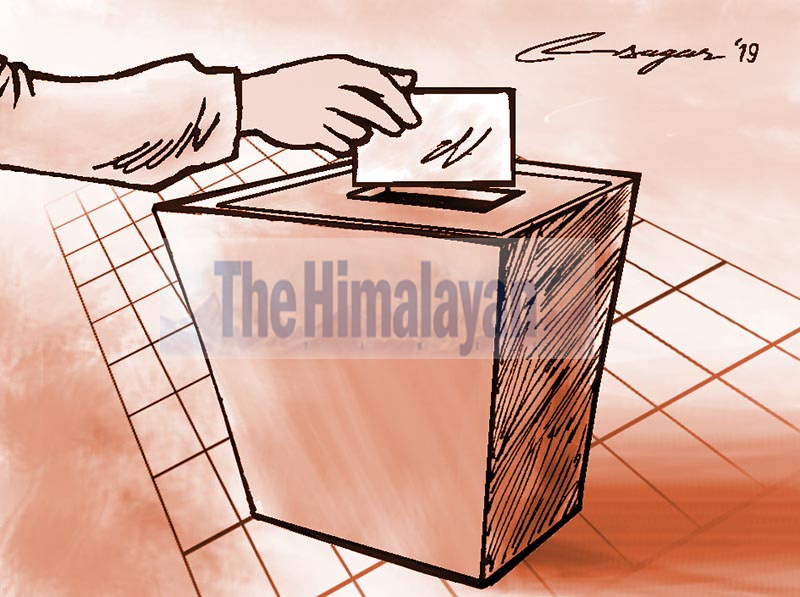Elections in Nepal: Mixed system needed
Elections, which are getting costlier all the time, need the attention of all the stakeholders. If the election is conducted under an integrated mixed system, it will not only limit the cost of electioneering but also make the elected representatives responsible to their voters
Generally, there are two extreme views that represent two major electoral systems. The First-Past-the-Post (FPtP) system is based on plurality of votes. A candidate is elected by securing the highest number of votes against the other contestants. The second is Proportional Representation (PR) system, in which representatives are elected proportionally as per the votes received by the party.
These two opposite systems have merits and also demerits. In the least developed countries and also in developing countries, the FPtP has bad effects on politics. Government formation is easy as candidates get elected with the highest number of votes without needing a majority. In multi-cornered contests, it is possible to get elected even with the least votes, as votes are divided into many candidates. In reality, majority of the votes get wasted by way of non-representation.
Voters are lured and intimidated to cast their votes in favour of a particular candidate, as voters are largely poor and uneducated. Caste, clan, ethnicity and creed play important roles in winning elections. Goons, criminals and contractors with easy money are gradually entering electoral politics and are capturing state power. The quality of politics has deteriorated, as personal interests of making money have shadowed the politics of public interests, and welfare of the masses is no longer the goal of political leadership.
Comparatively, the PR system is less expensive. In it, personal credibility and integrity of the candidates are not at stake. Sadly, in a country like Nepal, candidates are chosen not fairly but on a subjective basis. Senior political leaders nominate their kith and kin for the PR seats. Sometimes, money also plays a major role in getting a nomination from the party. It is commonly claimed that the representatives elected under the PR system are not the real representatives as they have no specific geographic areas to represent or any geographic constituency.
Hence, it is now felt that a new system can be evolved by integrating the merits of these two systems and discarding their demerits. The hybrid system will suit countries like Nepal, which adopt both the plurality/ majority system and mixed system to elect legislators to run the government. In the proposed system, the PR system can be introduced to limit the seats of the parties as per their votes’ share or their proportionality in translating the votes received into seats won. In the PR system, not only the link between the elected legislators and their constituents is weakened, but the link between the voters and their representatives is also destroyed.
Hence, the PR candidates will not be declared elected only as per the list submitted by the parties. To get elected they have to obtain at least the highest or plurality of votes as under the FPtP system. This will make the candidates responsible to their voters, and the voters will also know their real representatives.
The New International IDEA Handbook rightly holds, “It promotes a link between constituents and their representatives, as it produces a legislature made up of representatives of geographic areas. Elected members represent defined areas of cities, towns or regions rather than just party labels.” It further rightly states, “Some analysts have argued that this ‘geographic accountability’ is particularly important in agrarian societies in developing countries”. Under the FPtP, all candidates having the highest or majority votes will not be elected, as the seats available to the parties are limited under the PR scheme. All parties will have seats in proportion to the votes received. The number of seats will be as per the natural threshold.
Currently, as per new the constitution, 165 seats are elected under the FPtP. Out of 165, one-constituency districts number 35, and the remaining 42 districts are multi-constituency. The one-constituency districts will elect their representatives under the FPtP only. The seats won by the parties will be adjusted against their proportional quotas. Similarly, the smaller parties, whose shares will be meager, will get preference in getting their nominees elected on a priority basis even if these parties do not win plurality of votes in any constituency. Similarly, independent candidates will be elected with plurality of votes. The rest of these seats will be proportionally won by the major parties with plurality or majority of votes in individual constituencies.
Elections, which are getting costlier, need immediate attention of all the stakeholders. If the election is conducted under an integrated mixed system, it will not only limit the cost of electioneering but also make the elected representatives responsible to their voters. Elections for the 110 PR seats will continue as they are, and there will be one ballot for both the segments to reduce the cost of elections in the days to come.
The logic behind the integration is that winning the election or getting the highest number of votes in a constituency will not guarantee the victory of the candidates, the seats to be won by the parties are limited in proportion to the votes received on a national basis under the PR. When winning an election using money and muscle is not guaranteed, no candidate will use them to get votes.
Mishra is former election commissioner






